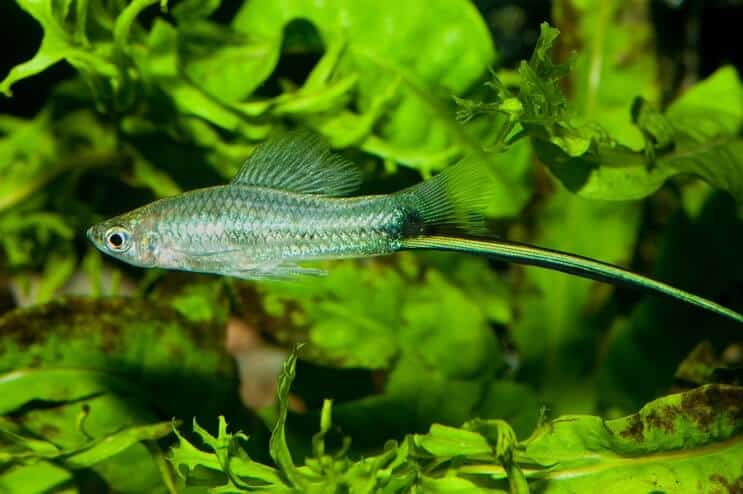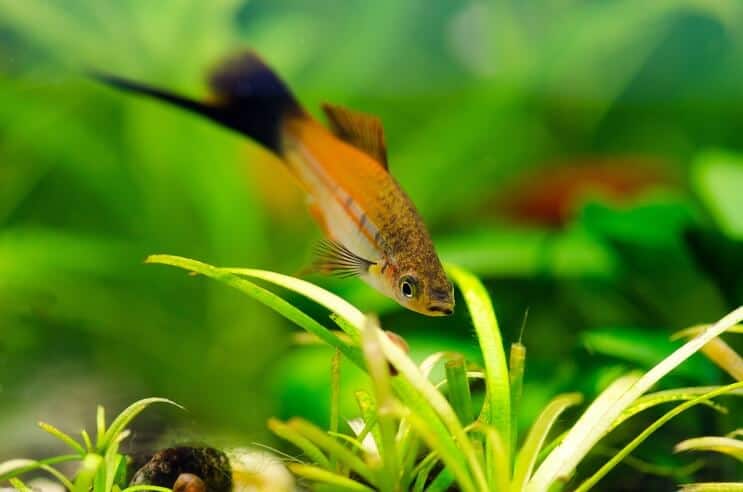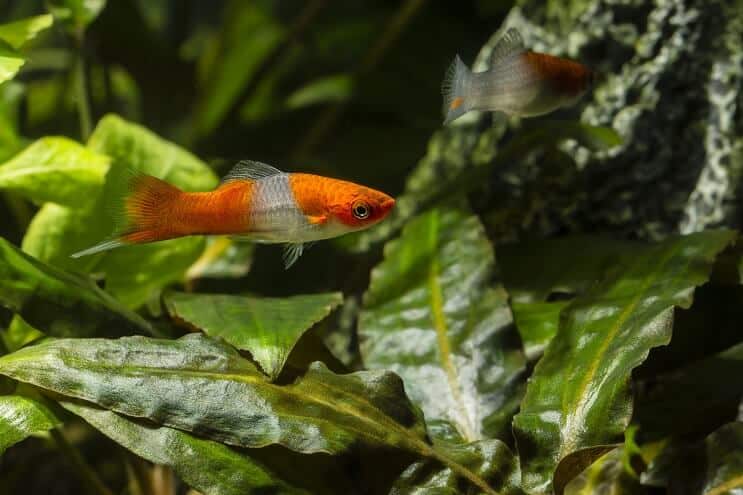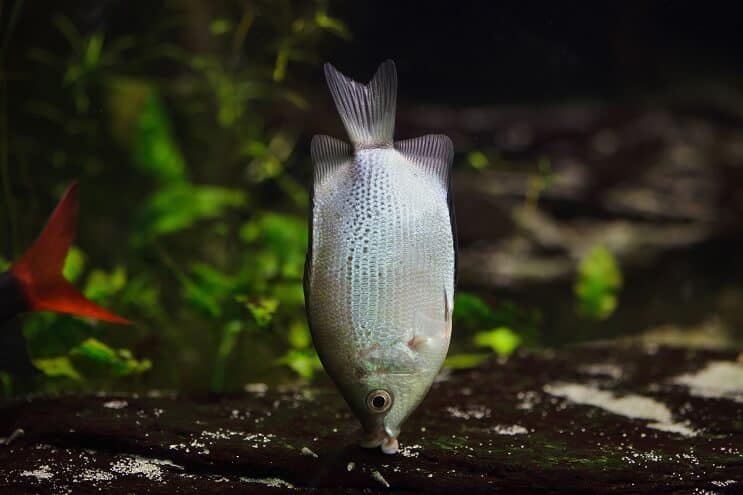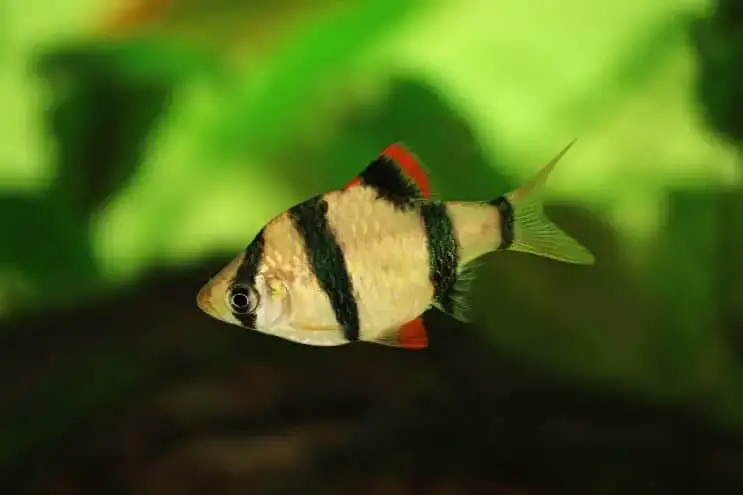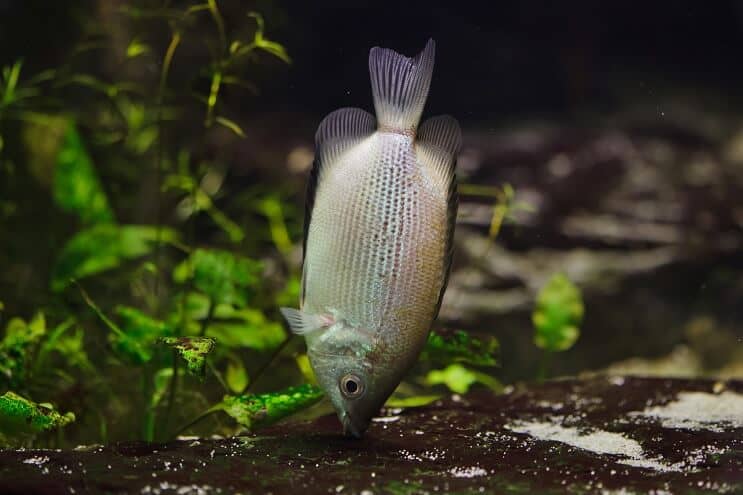Black Tetra

Originating in South America, the black tetra is not only one of the most popular species in the group but one of the most popular aquarium fish in general.
These modest-looking schooling fish only reach up to about three inches in length. Their small size makes them a great choice for a community tank.
The appearance of black tetras is a beautiful combination of dark shades with pretty black patches running vertically across their bodies and small, ripple-like dots covering the area of their bodies closer to the tail.
Their fins form a neat, densely packed grayish fan that attaches seamlessly to their bodies.
Black tetras are an amazing choice if you are looking for a small yet beautiful addition to your community tank.
Cardinal Tetra

The cardinal tetra has earned its popularity due to its stunning appearance and size.
Cardinal tetras can grow up to 1.5 inches long in good aquarium conditions, and if you are lucky, they may end up being slightly bigger than that.
These fish belong to the Paracheirodon genus, which is known for fish that exhibit an iconic, bright iridescent line that spans both sides of their bodies. Combined with their outstanding red coloring, these fish put on amazing light shows in the tank when the sunlight hits one of them.
Neon Tetra Fish

Relatives of the cardinal tetra, neon tetras have been in the aquarium of pretty much every fishkeeper in the world. They come from the same tropical basins of South America as black tetras and cardinal tetras and reach up to 1.5 inches in length.
What separates them from cardinal tetras is the difference in coloring. The upper part of their bodies near the dorsal fin is significantly darker than that of the cardinal tetra and is usually black or greyish.
Neon tetras also tend to have a lot less red on their bodies than cardinal tetras, but they have retained the iconic red line. This line, however, only stretches halfway across their bodies.
Neon tetras are a great choice for a community tank or any other kind of setup that would fit into a small- or medium-sized aquarium.
Green Neon Tetra

The green neon tetra comes from the same genus and family as both the neon and cardinal tetra. You can easily mistake it for one of these species because of how masterfully it conceals the greenish shade.
Although its appearance is similar to that of its relatives, the green neon’s abdomen has a mix of green, as does the upper part of its body. The signature line of neons also has a greenish shade to it.
Like many other tetras, green neons grow up to 1.5 inches in length.
Flame Tetra

Also referred to as red tetras, flame tetras are known as some of the most beautiful species by aquarium enthusiasts. Their incredible and vibrant appearance will light up any community tank like no other breed.
The scales of the flame tetra are so delicate that its body is almost transparent. The coloration of these fish is an exciting mix of red and orange.
Depending on the individual fish, they may have a couple of black patches closer to their head. Flame tetras are also one of the smaller types of tetras a maximum length of 1.2 inches.
Blue Tetra
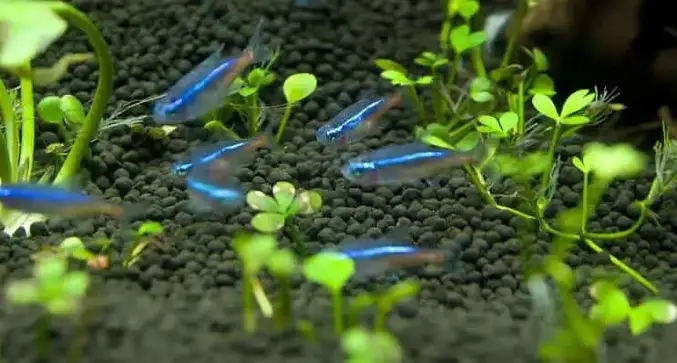
An Amazon native, the blue tetra has one of the most unique appearances of all the tetra species, despite largely consisting of only one color. Most of its body is either dark blue or purple, with central parts more saturated and darker.
The iridescence can still be seen in those fish if the lighting is right. If you are looking straight at it and the light hits their side at the right angle, you will witness nature at its finest.
These active little fish reach up to 2.3 inches in length and usually live for up to 3.5 years in good conditions.
Ruby Tetra

The ruby tetra is an interesting member of the tetra family.
This species has a very unusual body shape – it’s quite thin, compressed on the sides, and while other species have a more rounded body, this one is prolonged.
The coloring of the ruby tetra consists of light orange with some red gradients, especially closer to the upper side of the body. Its abdomen is white, and so are its fins for the most part. The ruby tetra grows up to 1.6 inches in length but surprisingly, it can grow larger in captivity.
Rainbow Tetra

One of the most in-demand aquarium species in the world, the rainbow tetra continues to spark up a flame of excitement in aquarists of all ages. No matter what angle you look at it, it never appears the same twice.
The rainbow tetra is blue, green, white, and grey, but its iridescence is what makes all the colors of the rainbow come together. This tetra species doesn’t get too big, with most adults reaching up to 1.5 inches in length.
This species is a great addition to your community tank and is bound to bring a nice colorful splash into every aquarium.
Ember Tetra

A small, peaceful fish, the ember tetra is a beautiful species. Its personality combined with its vivid appearance makes the ember tetra an outstanding choice for a community tank.
Ember tetras glow bright orange, and their skin is so thin that it makes them look almost transparent.
These little swimmers grow up to one inch in length and are quite easy to care for. They look majestic against a planted background and will be a great fit for a community tank. If you are keeping a planted tank, embers are a must-have!
Lemon Tetra

Also native to South America, the lemon tetra is a well-known and sought-after tropical aquarium fish. Its appearance makes it easy to spot, even in a very crowded tank, thanks to its signature bright yellow markings.
Ember tetras are covered in tiny, compressed, densely packed scales, while their eyes are pitch-black with a beautiful red outline. They reach up to two inches in length and are quite easy to breed.
Diamond Tetra

An exquisite jewel among the tetra species, the diamond tetra gets its name from its intricate scale pattern that makes it shine bright like a diamond.
The diamond tetra’s body is greenish in color with a mix of gray, black, and yellow. These fish have beautiful veil-like fins and black eyes that are brightly outlined with vivid red.
They look magical in a medium planted community tank alongside other members of the family or other small freshwater fish. Diamond tetras are not a demanding species and can be easily bred in the tank.
Emperor Tetra

How about a drop of royal blood in your tank?
Emperor tetras are known for their distinct coloring and sturdiness.
An interesting thing to note is the difference between male and female emperors; males have dark purple coloring while females have a more modest grayish coloration.
Originating from Colombia, emperor tetras have become a favorite for many aquarists due to how well they fit into community and single setups. They grow to only about 1.5 inches in captivity and don’t require a lot of attention.
Congo Tetra

Coming from the diverse Congo River, the Congo tetra has a radiant appearance. Its main coloration is a unique mix of blue, red, yellow, and green. Its scales are large and easily distinguishable.
The fins of the Congo tetra are mainly gray, with only the tail having a black outer lining.
Congo tetras will stand out in an aquarium not only because of their unique appearance but because of their size. These tetra fish can reach up to three inches in length, which is considered large for this family.
If you are looking for a new exciting fish to add a bit of color to your tank, the Congo is a great choice.
Bloodfin Tetra

Bloodfin tetras are a wonderful choice for beginners because of their sturdiness and sociable attitude.
Like other tetra species, bloodfins love to form schools, which can be an extremely useful characteristic in community tanks.
Bloodfin tetras are grayish with bright red fins, which is where they get their name.
Depending on the individual fish and the environment, the coloration of its fins may be lighter or darker (this is also a good indicator of the water quality in your tank, with darker colors indication healthier fish).
Rummy Nose Tetra

Showcasing an interesting fusion of styles and color, rummy nose tetras are loved by fishkeepers because of their long lifespans and peaceful temperaments. Their bodies are covered in small, tightly packed scales.
The rummy nose tetra has a bright red head, which is why it has its name. The rummy nose’s tail is a much more tasteful pattern, with an elegant mix of black and white patches.
These fish reach up to 2.5 inches in length and can live for up to 8 years. Not a fish to miss if you are a true aquarium enthusiast.
Buenos Aires Tetra

Combining the unique physical characteristics of several other tetras, the Buenos Aires tetra is a highly regarded fish. First described more than a century ago, this species has become a staple in many aquariums since then.
The Buenos Aires tetra’s appearance is a brilliant combination of red fins and a vibrant line across its body. The brilliant colors of this fish stand out boldly and look amazing in community tanks. Buenos Aires tetras are also quite large for tetras, growing up to 3 inches in length.
Although a great choice for community tanks, these fish require a bit more attention when it comes to water quality than other tetra varieties.
Penguin Tetra

Last but not least, the penguin tetra is also sometimes called the blackline penguinfish or the hockey-stick tetra.
Highly sociable fish, penguin tetras easily form schools and feel comfortable with at least two other companions in a tank.
Their appearance is very distinctive, consisting of a dark black line that spans both of their sides with a light-yellow outline. Their bodies are gray and their fins are very thin and almost transparent.
Habitat and Tank Conditions

Tetras are a very diverse group whose members come from many different environments. Some are native to tropical regions of South America, while others are more used to the damp climates of East Africa, with seasonal heavy rains and wide rivers.
Typically, tetras can be found in medium or large lakes, ponds, rivers, and wetlands.
The conditions in these habitats vary, but most of the time, the bottom would be covered in leaves or wood and there would be a canopy formed overhead by the surrounding trees.
Interestingly, despite their varied locations and habitats, you can keep most types of tetras together in the same tank. Although it may seem that they are incompatible because of their geographic distribution, they can all thrive within the same range of parameters.
Tank Setup
Most tetras feel comfortable in a moderately warm tank with a temperature ranging between 75°F–80.5°F.
Keeping the water range within these limits is important to prevent sickness. Lower temperatures drastically reduce the activity of your fish and slow down their metabolisms.
These fish require a pH of 6–7 and a water hardness of 12–15 dGH.
As these fish are active swimmers, you need to install a good filter in order to create a medium to hard flow. This will help to closely resemble their natural environment that is never static and is always moved around by either the wind or water currents.
The substrate you choose is completely up to you and will depend entirely on your personal preference, as tetras are not too picky. The substrate in their natural environment has always been moved around and resembles more of a mix, rather than homogenous material.
Another important aspect of the aquarium is live plants.
Whereas some fish will tear down any plants in their sight, tetras love and can cohabitate with even the most delicate plant species.
What Size Aquarium Do They Need?
They should be kept in a tank that is at least 10 gallons. However, this size should increase depending on how many specimens you decide to keep and whether you are planning on making a community aquarium.
How Many Can Be Kept Per Gallon?
You should allow at least two gallons for each tetra.
Caring for Tetras

Tetra fish are appealing for fishkeepers because they require very little maintenance.
This is because of their size and natural sturdiness. It’s a true win-win situation for aquarists.
The majority of species are not prone to any particular disease, but they are very susceptible to changes in water conditions, so you will have to keep this in mind and perform bi-weekly water changes.
Regular water changes help keep the water aerated and prevent it from becoming stale, which helps break the life cycles of parasites and harmful bacteria.
You should also check whether your fish has any individual illnesses or chronic conditions, such as mycobacteriosis.
Sometimes when a fish falls ill, people immediately assume that this has to deal with the quality of the water.
However, water quality is not always the problem and sometimes the disease may have been triggered by a slight change in the environment or any small chemical. This is especially dangerous if you are installing new equipment in your tank and invasive microorganisms sneak in.
Because of their size, tetras can be kept in small aquariums, and finding compatible neighbors is not a difficult task.
Diet & Feeding
The majority of tetra types are native to tropical regions of South America. The well-known Amazon River, its tributaries, and countless estuaries have proven to be a very fertile environment for aquatic life.
Here you will find warm, well-oxygenated waters with an abundance of food.
Tetras will eat everything they can get to, including insects that end up on the water surface and smaller freshwater organisms.
Just like in the wild, in the aquarium, these species are not picky with food. They will happily feed on all sorts of foods, including granules and flakes. Tetras will eat both frozen and dry foods, and will also gladly feast on live food.
Because tetras are usually kept in schools, you should get an automatic food dispenser, which will ensure that every fish gets enough food and also help you avoid overfeeding.
Feed tetras twice a day, as much as they can eat in a period of around two minutes.







































